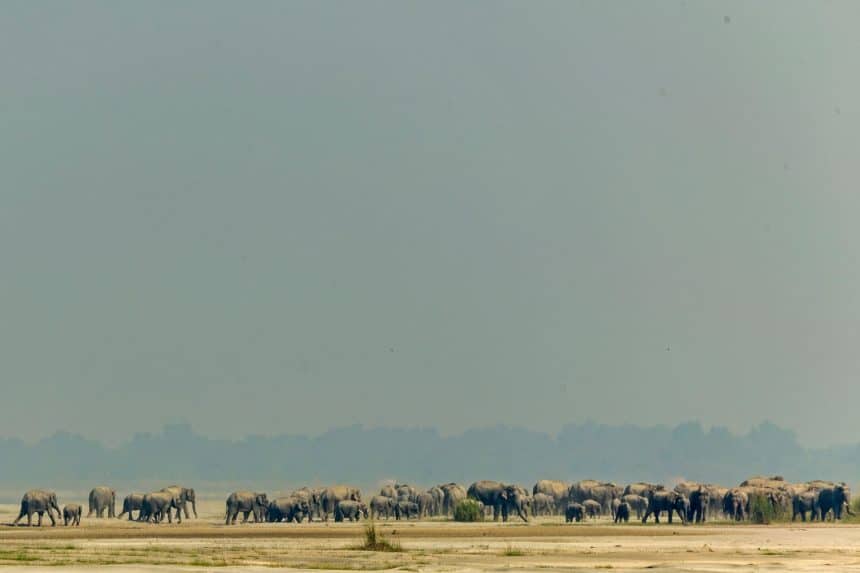Hundreds of the Gentle Giants—males, females and calves; crossing the Brahmaputra near Neamati Ghat, a rare sight!—we watched mesmerized; this large population on a deserted island from the shore of the Brahmaputra as we were driving to the airport for departure transfer of the guests on MV Mahabaahu. Everyone was elated at this huge rumble on the silver sands.
We were witnessing the annual migration of the Elephas Maximus (Asian elephants) here in Assam. This elephantidae family had crossed the Suban Siri River, walked through Majuli and had swim through the Brahmaputra to relax on a deserted sand island. This was the Masaai Mara moment for us in Assam.
The little babies walked close to their mothers and the mothers keenly watched over all new-born—a vivid display of matriarchal behavior; the males distanced themselves and walked alone or in a group.
Boat Safari onboard MV Mahabaahu
 A boat safari on the Brahmaputra brings us up close with the animals and observing the elephants from the river side, gives a clear understanding of their behavior. We can see a lone tusker walking along the shore after swimming across from the north shore to the south bank and entering Kaziranga. Watching elephants in close proximity on a boat safari can be very exciting. We can see the twin dome head of an Indian elephant in comparison to its African counterpart with one dome head.
A boat safari on the Brahmaputra brings us up close with the animals and observing the elephants from the river side, gives a clear understanding of their behavior. We can see a lone tusker walking along the shore after swimming across from the north shore to the south bank and entering Kaziranga. Watching elephants in close proximity on a boat safari can be very exciting. We can see the twin dome head of an Indian elephant in comparison to its African counterpart with one dome head.
Elephants in Peril:
Exploring the Lives, Threats, and Conservation Efforts for Asian and African Species
The flora and fauna enthusiasts travel the world to observe and understand species in different parts of the world and understand their life skills. The elephant world or the Elephantidae family is mostly divided into African and Asian.
Asian elephants live in India, Nepal and South-east Asia. The African elephants abound in sub Saharan Africa, the rain forests of West Africa and Sahel desert in Mali.
When we think of elephants, most of us conjure up images of trunks and tusks. Tusks are ivory and in demand and cause of the elephants to be put under endangered catalogue. Males have large tusks. Female Asian elephants have small, brittle structures called tushes. They look like small tusks, but they don’t have dental pulp inside of them and only grow to be a few inches long.
Deep Bonds and Communication
It is seen that elephants can form deep bonds, show empathy and even mourn death of a fellow elephant in the group. Elephants communicate through vibrations produced by impacting the earth’s surface or acoustical waves that travel through the earth by walking or rumbling. The frequency of male rumble is about 12Hz, and a female is around 13 Hz. A calf’s rumble stands at 22 Hz.
Elephant Corridors in India
The North-East has 58 elephant corridors numbering. From the eastern border of Nepal in north—West Bengal—western Assam– along the Himalayan foothills as far as the Mishmi Hills—extending into eastern Arunachal Pradesh—the plains of upper Assam—the foothills of Nagaland–the Garo Hills of Meghalaya—the Khasi Hills—the lower Brahmaputra plains—the Karbi Plateau; isolated herds occur in Tripura, Mizoram, Manipur, and in the Barak Valley districts of Assam
More than 53% of elephant population is in the south of India. There are 46 elephant corridors. In south – eight populations are fragmented from each other in northern Karnataka, in the crestline of Karnataka–Western Ghats, in Bhadra–Malnad, in Brahmagiri–Nilgiris–Eastern Ghats, in Nilambur–Silent Valley–Coimbatore, in Anamalai–Parambikulam, in Periyar–Srivilliputhur, and one in Agasthyamalai;
Elephants are sacred symbols in Hindu and Buddhist religions
They represent loyalty, power, wisdom, fertility, water and rainfall. In the Asian culture, elephants are symbols of strength, wisdom, and intelligence.
Human Encroachment into Elephant strongholds
Cutting forests for agriculture forces these mammals to raiding the crop and sometimes people get killed.

















Leave a Reply
You must be logged in to post a comment.